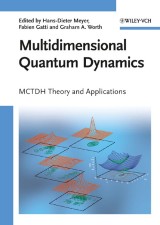Details

Multidimensional Quantum Dynamics
MCTDH Theory and Applications1. Aufl.
|
205,99 € |
|
| Verlag: | Wiley-VCH |
| Format: | |
| Veröffentl.: | 22.04.2009 |
| ISBN/EAN: | 9783527627417 |
| Sprache: | englisch |
| Anzahl Seiten: | 442 |
DRM-geschütztes eBook, Sie benötigen z.B. Adobe Digital Editions und eine Adobe ID zum Lesen.
Beschreibungen
The first book dedicated to this new and powerful computational method begins with a comprehensive description of MCTDH and its theoretical background. There then follows a discussion of recent extensions of MCTDH, such as the treatment of identical particles, leading to the MCTDHF and MCTDHB methods for fermions and bosons. The third section presents a wide spectrum of very different applications to reflect the large diversity of problems that can be tackled by MCTDH.<br> The result is handbook and ready reference for theoretical chemists, physicists, chemists, graduate students, lecturers and software producers.
Introduction<br> THEORY<br> The Road to MCTDH<br> Basic MCTDH Theory<br> Integration Schemes<br> Preparation of the Initial Wavepacket<br> Analysis of the Propagated Wave Packet<br> MCTDH for Density Operators<br> Computing Eigenstates by Relaxation and Improved Relaxation<br> Iterative Diagonalzation of Operators<br> Correlation Discrete Variable Represenation<br> Potential Representations (potfit)<br> Kinetic Energy Operators<br> <br> EXTENSION TO NEW AREAS<br> Direct Dynamics with Quantum Nuclei<br> Multilayer Formulation of the Multiconfiguration Time-Dependent Hartree Theory<br> Shared Memory Parallelization of the Multiconfiguration Time-Dependent Hartree Method<br> Strongly Driven Few-Fermion Systems -<br> MCTDHF<br> The Multiconfigurational Time-Dependent Hartree Method for Identical Particles and Mixtures Thereof<br> <br> APPLICATIONS<br> Multidimensional Non-Adiabatic Dynamics<br> MCTDH Calculation of Flux Correlation Functions: Rates and Reaction Probabilities for Polyatomic Chemical Reactions<br> Reactive and Non-Reactive Scattering of Molecules From Surfaces<br> Intramolecular Vibrational Energy Redistribution and Infrared Spectroscopy<br> Open System Quantum Dynamics with Discretized Environments<br> Proton Transfer and Hydrated Proton in Small Water Systems<br> Laser-Driven Dynamics and Quantum Control of Molecular Wavepackets<br> Polyatomic Dynamics of Dissociative Electron Attachment to Water Using MCTDH<br> Ultracold Few-Boson Systems in Traps
Hans-Dieter Meyer is apl. Professor at the University of Heidelberg. He received his PhD in 1978 from the University of Gottingen under the supervision of Professor J.P. Toennies. A postdoctoral year working with W.H. Miller at Berkeley followed before he moved to Heidelberg in 1980. He has published more than 170 articles in refereed journals treating various problems including heavy-particle scattering, electron scattering, computation of resonances, semiclassical methods, quantum chaos, vibronic coupling, system-bath problems, and internal vibrational energy transfer. Over the last decade, this work was mainly concentrated on the development and application of the MCTDH method.<br> <br> Fabien Gatti is Research Associate Professor in the French Centre National de Recherche Scientifique (CNRS). He studied at the Ecole Normale Superieure de Cachan, has an aggregation in chemistry and received a Masters degree in quantum physics at the Ecole Normale Superieure of Paris (1996). He received his PhD in 1999 under supervision of Professor C. Iung in Montpellier. He spent a postdoctoral year in Heidelberg working with Professor Hans-Dieter Meyer before moving to Montpellier in 2002. His present work is concentrated on MCTDH and the derivation of kinetic energy operators in curvilinear coordinates.<br> <br> Graham Worth is a Research Fellow at the University of Birmingham. He studied chemistry at the University of Oxford and obtained his DPhil in 1992 under the supervision of Prof. W.G. Richards. Postdoctoral studies followed in Heidelberg, first at the EMBL, then at the University as a Marie-Curie Fellow, where he worked with Hans-Dieter Meyer on the development and implementation of the MCTDH method. After working at King?s College London and Imperial College he moved to Birmingham in 2005. His main research interest is the simulation and understanding of ultrafast laser experiments.<br>
Science aims to correlate observable molecular properties with the internal workings of molecules as a means to design novel structures with specific properties. Determining atomic motion within molecules, i.e., their dynamics, is the key to this. With growing size it becomes impossible to implement the most precise and correct method, quantum mechanics. Computationally cheap classical mechanics are too crude for the finer points, which has led to the investment in improving quantum dynamical simulations for larger molecules. Better algorithms are more important than bigger computers, and MCTDH is the best to date. The first section of the book contains a comprehensive description of MCTDH and its theoretical background, and the second section a discussion of recent extensions of MCTDH, such as the treatment of identical particles, leading to the MCTDHF and MCTDHB methods for fermions and bosons. The third section presents a wide spectrum of very different applications to reflect the large diversity of problems that can be tackled by MCTDH.<br> The result is a handbook and ready reference for theoretical chemists, physicists, chemists, graduate students, lecturers and software producers.<br>
Diese Produkte könnten Sie auch interessieren:

Chemistry for the Protection of the Environment 4

von: Robert Mournighan, Marzenna R. Dudzinska, John Barich, Marjorie A. Gonzalez, Robin K. Black

213,99 €















